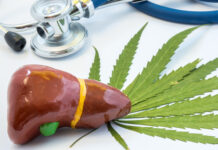This article takes a look at cannabis edibles, how they differ from other consumption methods and instructions on making medical cannabis-infused foods.
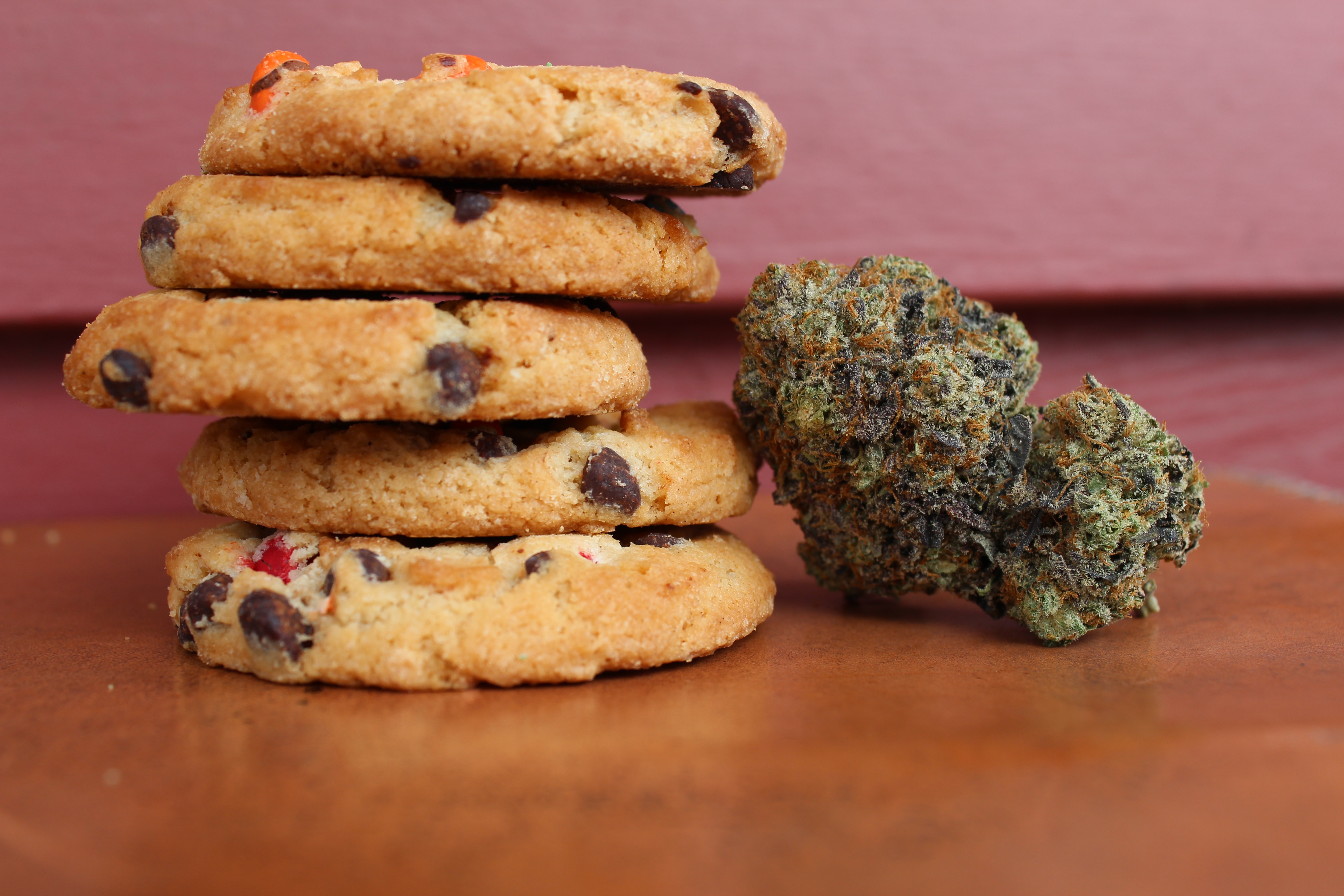
 What are Cannabis-infused Foods?
What are Cannabis-infused Foods?
Cannabis-infused foods or otherwise known as cannabis “edibles” are food products that have cannabinoids such as THC and CBD in them. Edibles are available in a tasty assortment of delicious treats from ever-popular brownies to pastries, cookies, candies, and gummies. Patients can also infuse medical cannabis into smoothies, coffee and other drinks as well.
As such, edibles are a very attractive and enjoyable consumption method for medical patients who wish to avoid smoking or vaporizing their dried flower. Edibles as well as extracts and cannabis topicals will be available for purchase in late 2019 and early 2020.
Advantages of edibles include:
- Wide assortment of food and drink possibilities
- Healthier consumption method than smoking
- Effects are long-lasting (3 to 12 hours)
- Effects can be stronger and more pronounced
Disadvantages of edibles:
- Effects take much longer to take effect (1 to 4 hours)
How Do Edibles Work?
Unlike other consumption methods like vaporization, edibles will take the longest amount of time for their effects to be felt. This is because edibles are digested and absorbed through the digestive tract and therefore, it may take up to 2 to 4 hours for full effects to kick in. Effects can last up to 12 hours. Health Canada has already established a maximum allowable THC concentration of 10 mg for a single serving edible package.
However, consuming cannabis will always differ from person to person. One must take into account factors such as age, body composition, physical health, and history of mental health history. Patients should always work with their healthcare practitioner for guidance and monitoring.
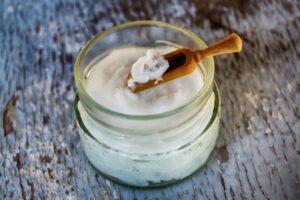 Patients Can Make Their Own Cannabis Edibles
Patients Can Make Their Own Cannabis Edibles
With cannabis edibles not available for purchase until sometime late 2019 or early 2020, patients can opt to cook up their own cannabis-infused food creations. It may seem daunting at first, but cooking with cannabis is a relatively straight-forward and simple procedure.
The first thing to keep in mind is cannabinoids like THC and CBD are fat-soluble compounds, meaning they must be immersed in a fat carrier in order to effectively mix and dissolve. The best fat carriers for cooking cannabis include butter and cooking oils such as coconut oil and olive oil. Coconut oil is especially ideal for cannabis because it contains higher amounts of fatty acids, which help to effectively bind and preserve cannabinoids during the extraction process.
The fundamental principle behind cooking with cannabis is combining roughly chopped dried flower with some type of fatty cooking medium such as butter or oil and applying low heat to cook and release the cannabinoids.
 How to Make Cannabis-Infused Oils and Butter
How to Make Cannabis-Infused Oils and Butter
Before actual cooking, here’s the ingredients required:
- 1 cup of roughly ground up dried flower cannabis
- 1 cup of butter or oil
- 1 large saucepan or large pot
- cheesecloth
- strainer
- ample preparation time
- 1 large and thick mason jar
 Step 1: Grinding up your dried flower
Step 1: Grinding up your dried flower
Use a cannabis hand grinder to break up your dried flower into roughly chopped pieces of cannabis. Coffee grinders are not recommended as they will produce too fine of a powder, which won’t allow you to filter out undesirable plant matter from getting into the final product.
Step 2: Figuring out weed-to-fat ratio
The general rule is to use 1 cup of butter or oil for every 1 cup of cannabis. In the interest of medical cannabis patients who may be seeking all day relief, the amount indicated in this recipe is designed to produce moderately strong edibles. Feel free to reduce or increase the amount of dried flower cannabis according to your particular medical needs.
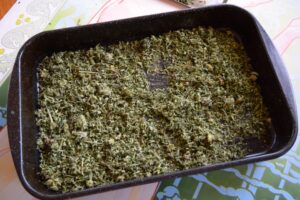 Step 3: Decarboxylating your cannabis
Step 3: Decarboxylating your cannabis
Before you can infuse your cannabis with your choice of butter or cooking oil, you first must “decarb” your cannabis in the oven. Decarboxylation is the process of applying heat in order to activate cannabinoid, THC-A to its usable, psychoactive form, THC. This is the most important step to ensuring your final edible product works as intended.
Preheat your oven to 240° F. Then evenly place your cannabis on a non-stick cooking tray and bake for 30 to 40 minutes. Periodically mix around the cannabis buds to ensure that your cannabis cooks evenly. Take out and set aside. Your cannabis should have a golden brown consistency.
 Step 4: Infusing Cannabis with Oil or Butter
Step 4: Infusing Cannabis with Oil or Butter
Now that your cannabis is sufficiently decarboxylated, it’s ready to infuse with your choice of butter or cooking oil.
Add one cup of water to your large saucepan or pot. Then, melt 1 cup of butter or cooking oil in it. Thoroughly mix in your decarbed cannabis into the large saucepan or pot as the butter is melting. Simmer on low heat for about 2 to 3 hours. Be sure to stir occasionally to prevent the mixture from scorching, which will destroy active cannabinoids. Allow time for the mixture to cool down before proceeding to the next step.
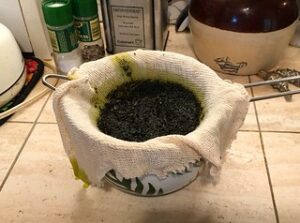 Step 5: Straining the Cannabis Mixture
Step 5: Straining the Cannabis Mixture
Now it’s time to separate the concentrated cannabis liquid from the mass of plant matter. Once your mixture has cooled down, you want to carefully filter the mixture into another container by straining it through a layer of cheesecloth. Since cheesecloth is porous, it will help catch all of the unwanted plant material from making it into the final mixture. When filtering it through the cheesecloth, avoid squeezing too hard as to avoid unwanted plant matter from seeping through the cheesecloth and into your final mixture.
After you’ve finished filtering, discard the remaining plant material.
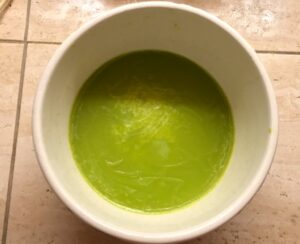 Step 6: Refrigerate
Step 6: Refrigerate
Now it’s time to store your strained mixture in the fridge for about one hour. This will help revert your cannabis mixture from liquid to solid form. Once removed, you’ll notice that the mixture has a distinct layer of water that has collected at the bottom. Don’t worry, this water will be very easy to remove. At this point, your butter/oil cannabis mixture should be solid enough to remove from the container using a fork or a knife. At this point, your cannabis butter/oil should take on a light green color. Remove your cannabis butter/oil and discard the leftover water. You’ve officially created your first cannabis-infused butter/oil, which you can apply to essentially any recipe that calls for butter or cooking oil.
As for storage, you may store your newly-made cannabis butter or cannabis-infused cooking oil in the freezer for up to 6 months or in the fridge for several weeks.
 Important Tip for Baked Goods Recipes
Important Tip for Baked Goods Recipes
Now you are ready to use your cannabis-infused cooking oil or butter as you normally would for recipes that list oil or butter as an ingredient.
One tip to always keep in mind is that most baked goods use a default temperature of 350⁰F. At this high temperature, you risk vaporizing your cannabinoids and wasting all of your hard work. It’s highly recommended to bake your edibles at a lower temperature that does not exceed 300⁰F and increase cooking time by 50 percent. This way ensures that essential active cannabinoids like THC and CBD will be adequately preserved.
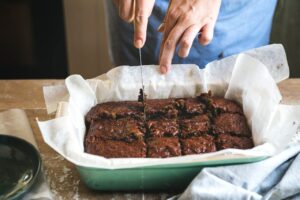 Portion Control
Portion Control
After creating your first batch of cannabis-infused edibles, it can be extremely tempting to consume more servings than recommended. Delicious as your edibles may be, keep in mind that they are infused with potent concentrations of cannabis. Given the delayed onset of effects with edibles, it’s extremely important to not exceed your recommended servings. Please start low, and go slow. Eat a small portion, and give yourself ample time to see how the effects make you feel before taking another serving. Taking too much can cause unwanted side effects. It’s also recommended to cook a second batch of non cannabis-infused edibles to help satiate potential cravings.
Cannabis Oil
Alternatively, patients can purchase cannabis oil tinctures from online retailers to infuse into their food and drinks. Cannabis oil is only made from producers who have been licensed by Health Canada and is held to the highest production standards and regulations.
Quick Facts About Upcoming Edible Products
- Maximum limit of 10 mg of THC per edible package
- Edible products will not contain nicotine or added alcohol
- The packaging is required to be plain and child-resistant
- All edible products will contain standardized cannabis symbol for products containing THC


